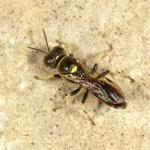Ceratocolus maurus (LEPELETIER & BRULLÉ,1835); Ceratocolus ziegleri (LEPELETIER & BRULLÉ,1835)
Common throughout the British Isles (Richards, 1980). Currently available data suggests this is probably still the case, but data lacks many records from Wales and Scotland. Lomholdt (1984) states that it is widely spread across Europe, with records also from Caucasus, Kazakhstan, Turkestan, Mongolia, Sakhalin and Japan.
This species is not considered to be under threat.
Found most often in sandy places, where suitable nesting substrates occur, including coastal dunes.
Richards (1980) gives May to September. The small data set currently available suggests that July and August are the peak periods, although this may be due to recorder activity on heathland during this period.
Generally small flies (Diptera), although Lomholdt (1984) gives an unreferenced suggestion that small Homopteran or Heteropteran bugs might also be taken.
Tsuneki (1960) determined that, in Japan at least, the nest is simple, with perhaps only one or two, but up to nine cells. Nests are generally excavated in sandy substrates although more clayey banks exposed to the sun may also be utilised (Lomholdt 1984).
No information is available.
No information is available.
2006


